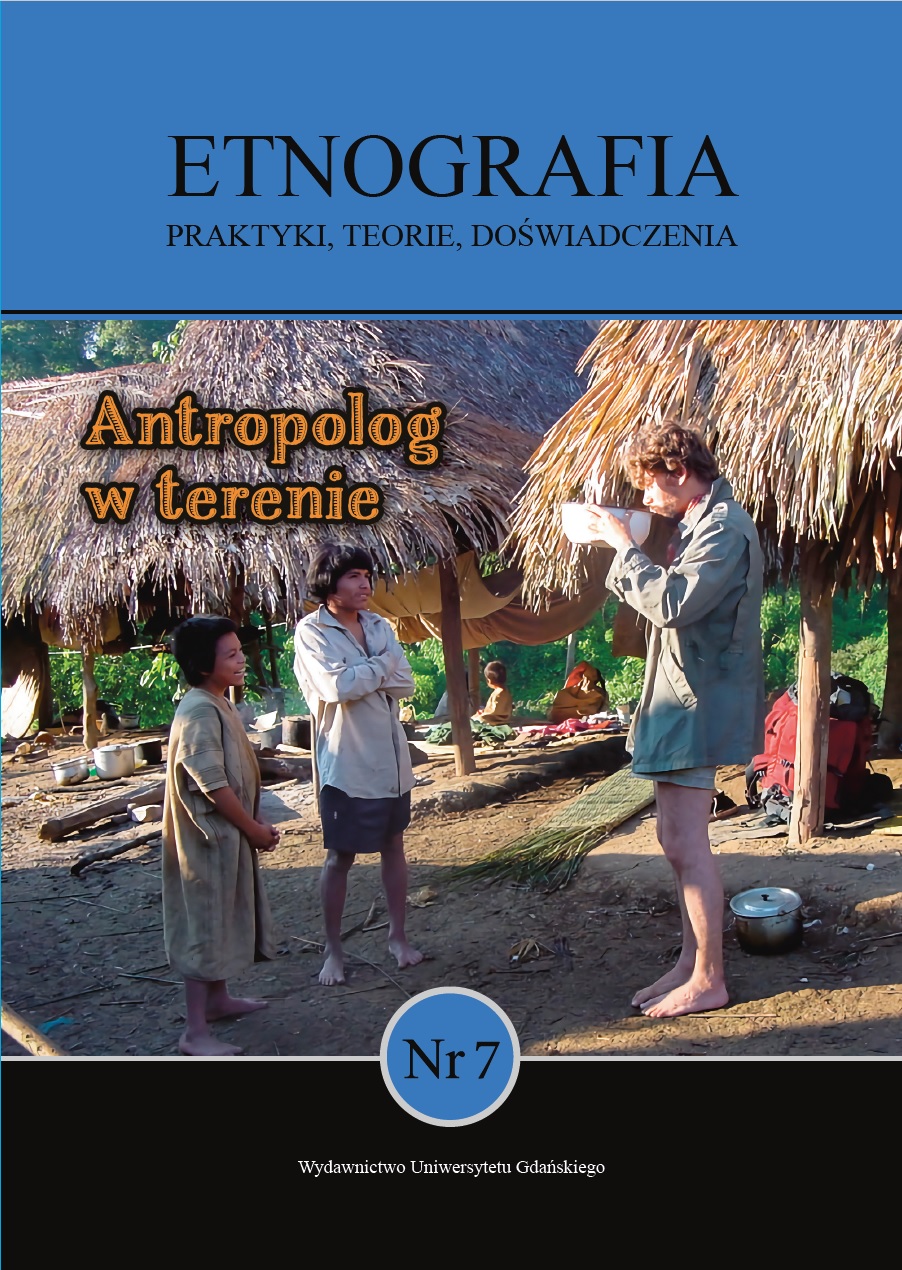Niematerialny świat Dul-dul at. O procesie zanurzania w świat Innych, o relacjach, ludziach i innych bytach
DOI:
https://doi.org/10.26881/etno.2021.7.16Słowa kluczowe:
Kyrgyzstan, petroglyphs, ethnography experience, human and non-human beingsAbstrakt
This essay is a non-linear record of memories from the author’s anthropological field- work in southern Kyrgyzstan. The research concerns a place called Dul-dul at, a site of petroglyphs with a dominant motif of animals interpreted as a pair of horses. The area at the foot of the rock with petroglyphs is also a pilgrimage and ritual site for healing and spiritual practices. The narrative of memories shows the transformation not only of the place of research, but also of the researcher: between the first stay (in 2006) to the last (in 2019). Subsequent studies reveal the dependencies of people involved in social rela- tions on the material and non-material world of Dul-dul at. Consecutive memories reveal layers of knowledge and ignorance, and how the researcher penetrates the community of the Others and the way they perceive the world.
Downloads
Bibliografia
Amanbaeva, B., Suleymanova, A., Zholdoshov, C. (2011). Rock Art in Kyrgyzstan. W: J. Clottes (red.), Rock Art in Central Asia. A Thematic Study. Paris: ICOMOS, 43–47.
Basilov, V.N., Kubakov, K.K. (1983). Survival of Pre-Muslim Beliefs in Islam. W: S.C. Dube, V.N. Basilov (red.), Secularization in Multi-religious Societies. Indo-soviet Perspectives (s. 227–240). New Delhi: Concept Publishing Company.
Bernštam, A.N. (1951). Drevnââ Fergana. Taškent: Izdatelʹstvo Akademi Nauk UzSSR.
Bùbù Mariam Musa kyzy (2014 a). „Duldul Bulak” Maza. W: Ajkôl Manas, Žajsan̦ Umôtuulu, t. 10 (s. 128–136). Biškek: Kylymkôčù.
Bùbù Mariam Musa kyzy (2014b). Meditations Section – unexpected meeting. W: Ajkôl Manas, Žajsan̦ Umôtuulu. Przekł. ang. A.S. Meimanaliev, t. 1 (s. 27–32). Biškek: Kylymkôčù.
Cieślewska, A. (2017). Islam with a Female Face. How women are changing the religious landscape in Tajiki stanand Kyrgyzstan. Kraków: Księgarnia Akademicka.
Favret-Saada, J. (2012). Śmiercionośne słowa, zabójcze uroki. Przeł. K. Marczewska. Warszawa: Oficyna Naukowa.
Geoffroy, E. (1997). Szaykh. W: C.E. Bosworth, i in. (red.), Encyclopaedia of Islam. New Edition, t. 9, San-Sze (s. 397–398). Lejda: Brill.
Golden, P.B. (2011). Central Asia in World History. New York: Oxford University Press.
Huart, Cl., Pellat, Ch. (1991). Duldul. W: B. Lewis, Ch. Pellat, J. Schacht (red.), Encyclopaedia of Islam. New Edition 2 (s. 624). Lejda: Brill.
Jessa, P. (2001). Współczesny szaman kazachski. Baksy Ajtkurman. Lud, 85, 193–208. Jessa, P. (2006). Aq jol soul healers: religious pluralism and a contemporary Muslim movement in Kazakhstan. Central Asian Survey 5(3), 359–371.
Jessa, P. (2009). Przyjaciele Allaha: kult muzułmańskich świętych w Azji Środkowej. Poznań: Wydawnictwo Poznańskie.
MacDonald, D.B., Massé, H. (1991). Djinn. W: B. Lewis, Ch. Pellat, J. Schacht (red.), Encyclopaedia of Islam New Edition 2 (s. 546, 548). Lejda: Brill.
Maničkin, N.A. (2019). Šamanizm i duhovno-magičeskie praktyki kyrgyzov. Moskva: Institut etnologii i antropologii im. N.N. Mikluho-Maklaâ RAN.
Penkala-Gawęcka, D. (2001). Wybrańcy duchów, czyli jak zostać szamanem. Na przykładzie ujgurskiej szamanki z Kazachstanu. Lud, 85, 153–191.
Pietrowiak, S. (2021). Celestial horses of Dul-dul at: Petroglyphs as the site of transformation and interaction in the Kyrgyz Fergana valley. Rock Art Research 38(2), 152–168. Saidov, A., Anarbaev, A., Goriyacheva, V. (2011). The Ferghana Valley: The Pre-Colonial Legacy. W: F.S. Starr (red.), Ferghana Valley. The Heart of Central Asia (s. 3–28). New York: M.E. Sharpe.
Schimmel, A. (1974). Mystical Dimensions of Islam. Chapel Hill: The University of North Carolina.
Tashbayeva, K. i in. (2001). Petroglyphs of Central Asia. Bishkek: International Institute for Central Asian Studies.
Tursunov, E.D. (1999). Vozniknoveniebaksy, akynov, sèriižyrau. Astana: IKF Foliant. Yarshater. E. (red.) (2011). Doldol. W: Encyclopædia Iranica. New York: Eisenbrauns. [online] http://www.iranicaonline.org/articles/doldol [Accessed 19.08.2020]
Ûdahin, K.K. (1965). Kirgizsko-Russkij slovarʹ, t. 1 A-K. Moskva: Sovetskaya Entsiklopediya. Uhlig, H. (2007). Jedwabny szlak: kultury antyku między Chinami a Rzymem. Przekł. J. Danecki. Katowice: Wydawnictwo Książnica.
Film
Seth, A. (2017). Your brain hallucinates your conscious reality. TED. https://www.ted.com/talks/anil_seth_your_brain_hallucinates_your_conscious_reality? [dostęp: 10.06.2020]
Opublikowane
Wersje
- 2023-10-17 - (2)
- 2021-12-23 - (1)
Jak cytować
Numer
Dział
Licencja
Czasopismo wydawane jest na licencji Creative Commons Uznanie autorstwa-Na tych samych warunkach 4.0 Międzynarodowe.

 Uniwersyteckie Czasopisma Naukowe
Uniwersyteckie Czasopisma Naukowe








